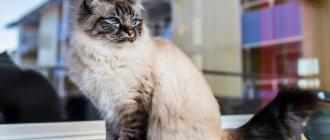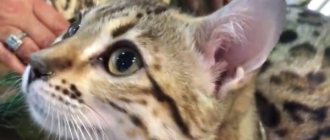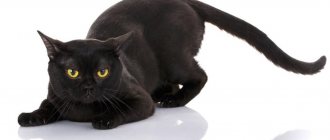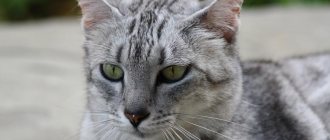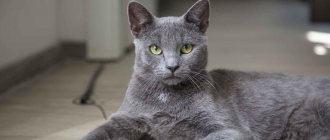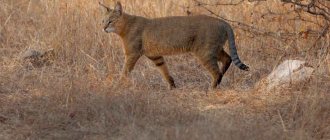A cute cat with a touching expression on her face, playful behavior and affectionate eyes is a hybrid of a “Persian” and a Munchkin. The body shape of Napoleon (minuet) is unique: short limbs are combined with the smooth outlines of the head and body, covered with luxurious fur, giving the animal the appearance of a living ball. Representatives of the breed are distinguished by their rare love of love and affection.
Origin story
The origin story of the dwarf cat, whose name mentions a world-famous commander, is simple and uncomplicated. On a warm June day in 1995, breeder Joseph Smith read an article in the morning newspaper about surprisingly cute munchkin cats. He was so delighted with these tiny short-legged fluffies that he set himself the goal of improving the breed as much as possible. And he succeeded, despite the fact that until that time he had worked exclusively with dogs (the appearance of the Basset Hound breed was solely his merit).
As a second participant in the process, Smith decided to involve the Persian breed, no less cute and fluffy than munchkins.
The first attempts suffered a crushing failure: the representatives of the new breed turned out to be beautiful, adopted the best features from their parents (from the Persians - a slightly flattened muzzle and soft shiny fur, from the Munchkins - miniature stature and tiny paws), but they could not boast of good health.
Multiple genetic defects led to cats dying at an early age, and getting an absolutely healthy animal was both difficult and expensive. Therefore, felinological organizations (except TICA) initially refused to register the new breed.
Smith was so upset that he gave up work and burned all his notes. However, there were others who took up the baton. Terry Harris, Margie Gardner and Sam Tate, full of enthusiasm, achieved what they wanted. The breed received another name – Minuet Cat, which means “small”. The new breed was approved, but with a caveat - the name “Napoleon” may offend the national pride of the French, so it is better not to use it.
Napoleon kitten price
How to buy such a treasure and how much will it cost you? Minuet is an expensive breed. This is due to the difficulty of breeding. The better the pedigree, the better the offspring and, accordingly, more expensive. The price for a Napoleon cat is around 30-90 thousand rubles. One of the factors in setting the price is the size of the kitten.
It is better to refuse to buy kittens from hand to hand and turn to qualified breeders. You can also find good nurseries where you can find your pet.
Even the best breeders can make mistakes, so you need to take the initiative and check the quality of the animal being sold to you.
- Please ensure that the tail is intact and intact, no breaks or unevenness.
- The eyes should be set wide apart and have clear mucous membranes. Ears should not be dirty.
- Look at the coat - it can say a lot, it should not be dull, but rather shiny and smooth.
- The kitten should have a good appetite, be cheerful and energetic, but if the kitten is lethargic, this may be a sign of illness.
- Pay attention to the pedigree to avoid all sorts of pathologies.
Standards
These miniature individuals, despite their apparent fragility, have a strong body, with well-developed muscles and a baby-face expression. They are harmoniously built and weigh very little - 2, maximum 3 kg. The minuet is the size of a six-month-old kitten of another breed (medium size). The external resemblance to the Persians immediately catches the eye, however, there are plenty of significant differences from the ancestor.
The standard from the American TICA system is as follows:
| Standard | Description |
| Head | Round, large, slightly flattened. The chin is clearly defined, small, neat. The cheeks are round. There is no “stop”, the nose is wide and straight, so these cats do not have breathing problems like Persians. |
| Neck | Short, strong. |
| Eyes | Large, round, widely spaced. |
| Ears | Medium size, widely spaced. Their tips are rounded, the inside of the auricle is abundantly pubescent. |
| Torso | Long, wide. The back is flat. Round shapes. |
| Paws | Strong and muscular, can be either short or long. Hair often grows in tufts between the toes. |
| Tail | Slightly longer than the body, covered with thick hair along its entire length. |
| Wool | It can be either short or long. But it is always pleasant to the touch, very soft and fluffy. |
There are 2 types of the breed: ordinary Napoleon and dwarf Napoleon (extreme). The common one weighs a little more, has larger paws, and its overall size is slightly larger. A dwarf Napoleon costs several times more than an ordinary one.
Mating is allowed with representatives of certain breeds. These are Persian, Himalayan, Munchkin and exotic cats with short hair. Until now, the breed is in its infancy.
Disqualifying features include the following: crooked nose; lacrimation; too long paws; break of the bridge of the nose. A significant drawback for which points are deducted at exhibitions: strongly pronounced brow ridges.
American Curl, weight up to 4.5 kg
The ancestor of all these cute and friendly cats was the stray cat Shulamith, in whose litter a genetic mutation occurred. After only 2 years, specialists began to specially breed curls as a variety. And after 3 - they were recognized as a separate breed.
These animals are distinguished from other cats by the tips of their ears that are bent back and their light weight - a maximum of 4.5 kg in a female. Curls come in both long-haired and short-haired varieties. The first ones have ears ending in tufts, long, like those of a lynx. The wool is soft and silky, the color can be any.
Character and behavior
"Napoleons" are unusually friendly cats. They easily fit into any family: large or small, with or without small children. The absence of any aggression makes them the best companion for babies: the cat “Napoleon” will allow itself to be wrapped like a baby in a diaper, and put in a pram, and dressed up in doll clothes. He will not let out his claws and will not allow himself to bite - the cat will understand the game and will happily “join in”, however, adults will need to make sure that the games do not go too far and the animal does not get hurt.
The “Napoleons” did not adopt the negative traits of their ancestors: they do not have a drop of the belligerence of the Munchkins or the arrogance of the Persians. They tenderly and devotedly love all family members, become attached to everyone and do not tolerate separation very well.
If your house is empty all day long, there are no human voices, laughter and warm hands, the minuet will get sick from melancholy and may even die.
These cats are called healers: many cat lovers believe that fluffy short-legged babies help the owner cope with depression and headaches, relieve fatigue and neuroses.
These cats love affection and are ready to sit for hours in the arms of their beloved owner, pressing their head against his shoulder and purring softly. This is an amazingly sensitive breed: cats always sense when the owner is in a bad mood and melancholy, and always come to support him. “Napoleons” are friendly towards everyone without exception, even strangers, and trustingly approach calls, and this is the main danger: cats can suffer from the wrong hands, so do not let them walk alone.
“Napoleons” easily get along with other cats: they do not claim supremacy, do not like to conflict and easily find a common language even with the most gloomy and warlike of their brothers. The same applies to small dogs.
But Minuet is afraid of large animals. The lack of hunting instinct makes them safe for poultry and rodents.
“Napoleons” are smart and quick-witted, quickly “grasp” new things and are easy to train. They can be taught some basic commands without any problems: “Sit”, “Come to me”, “Eat” and the like.
The breed is still rare, so the cost of a Napoleon kitten is high: from 35,000 to 70,000 rubles. The smaller the animal, the more expensive it is. It is worth clarifying that such a high price is only for a pet-class kitten: i.e. for a baby you plan to have exclusively as a pet.
You will have to look for a breeding animal for exhibitions abroad: in particular, in the USA. In this case, you will need to consult a high-class felinologist, study all pedigree documents and medical documents, because congenital anomalies and genetic mutations are still common today.
Which cat's smile walked on its own?
SiameseCheshire
Features of cat health
When crossing and breeding the breed, special attention was paid to ensuring that the “Napoleons” did not have most genetic mutations, but it was not possible to avoid them completely. Due to the numerous mixing of blood, congenital deformities and diseases that can be inherited cannot be excluded.
When buying a kitten, you should pay attention to its pedigree.
- We must not forget about deworming; carefully follow the parasite prevention schedule.
- Give vaccinations according to your kitten's age.
- Pay special attention to examining the kidneys and retina, these are the most likely organs that can fail in Napoleon’s body.
- Short legs interfere with the bearing and birth of kittens in this breed.
- With proper care, your pet will live 10-12 years, which is the average life expectancy of cats.
Care instructions
Caring for “Napoleons” includes standard procedures, there are no complicated manipulations, and if you teach your baby to use a scratching post and litter tray from an early age, you will have no problems with your pet at all.
Wool
Napoleon's fur requires attention. Short-haired cats need to be brushed every two days, semi-long and long-haired cats - every day.
Buy a brush with natural bristles (it does not electrify the coat), a mitten with rubber teeth (to improve blood circulation) and a wide-tooth comb (removes guard hairs). Scratch your pet from head to tail using soft, massaging movements. It is better to cut off the resulting tangles with nail scissors.
Bathing
You should bathe your cat 2-3 times a year (of course, if it is very dirty, you need to wash it quickly), using special cat shampoos (Bars, Doctor ZOO).
Claws
A scratching post is a necessary item in a house with a cat. If your pet is too lazy to sharpen its claws, trim them with a nail clipper once every 2 weeks. This is done at a right angle, carefully so as not to touch the large vessels of the fingers.
Ears
The ears are cleaned every week by soaking a cotton swab in chamomile infusion or ear lotion. Do not put drugs in your ears!
Teeth
Brush your teeth once a week using a silicone toothbrush and cat toothpaste from a pet store. For cats that refuse to let their owners use brushes, there is a special gel: it is dripped into the drinking water every day. But in this case, you will have to take the cat to the veterinary clinic once a year to remove tartar mechanically.
Expert opinion
Dusheba Vera Ivanovna
In 2010, she graduated from the Moscow State Academy of Veterinary Medicine named after K.I. Scriabin with honors, specializing in veterinary medicine. I regularly attend veterinary conferences, congresses, and webinars.
Start brushing with the front teeth: with smooth movements, without pressing hard, from the inside and outside, gradually moving to the far teeth. The procedure time is 15-30 seconds.
In the photo there is a cat of the Napoleon breed (Minuet)
Conclusions about the breed
What conclusions can be drawn about the miniature cat Napoleon? If we compare the advantages and disadvantages, we will make the following verdict:
- Excessive friendliness has a downside: the cat is often lonely, you need to play with it a lot, talk to it and simply pet it endlessly. If the owners are rare guests in their home, the breed is not for them.
- The cat is affectionate, you don’t have to worry about children and animals.
- If the cat's pedigree is impeccable, he will enjoy good health. Of course, with the right content.
- Maintenance is simple and not complicated. The main thing is to feed him well and keep his coat, eyes and ears clean.
Beautiful, playful and funny cat Minuet is waiting for her portion of admiration!
global $ads_google; //data-ad-slot=”2475549904″ $ads_google = empty($ads_google) ? false : true; ?> if ($ads_google == false) {?>
$ads_google = true; ?> } ?>
Catering
“Napoleons” love to eat tasty and satisfying food, so the first thing owners should watch out for is that the animal does not overeat. The tendency towards obesity in cats of this breed quickly turns cats into fat cats who stop moving and begin to suffer from related diseases.
Cat food must meet the following requirements:
- Do not contain parasites and their larvae, pathogenic bacteria, pesticides, hormones, GMOs and other substances harmful to cats;
- Replenish the animal’s needs for the minerals and vitamins necessary for its body (the diet should contain proteins, fats, carbohydrates, fiber, macro- and microelements.
Of course, all this requires not only time, but also financial costs, studying cat nutrition, maintaining hygiene during cooking and careful selection of products and ready-made food.
Young animals up to 3 months old are fed 6 times a day, kittens 3-4 months old - 5 times, up to six months - 4 times, from six months - 2 times, like an adult cat.
However, if the animal is weakened, suffers from any chronic diseases, bears or feeds offspring, the menu is revised, and the number of feedings is discussed with the veterinarian.
Food and drink should be at a comfortable temperature for the cat: not hot and not from the refrigerator. Water – only fresh, purified through a filter or distilled. Bowls are washed after each meal, water is changed 2 times a day: morning and evening. If there are several animals in the house, each receives its own portion in a separate bowl.
Natural products
What can you give your cat:
- Beef and veal, rabbit and turkey meat, lamb meat: daily. The meat is frozen, and before serving to the animal, it is doused with boiling water to destroy possible parasites and their larvae.
- By-products: hearts, liver, stomachs, chicken necks (ground into minced meat). Raw, with the exception of the liver - it must be boiled.
- Fermented milk products without the addition of flavor enhancers, dyes and chemicals: low-fat cottage cheese, kefir, fermented baked milk, sour cream, natural yogurt, Varenets, cream. Goat's milk in reasonable quantities, a little unsalted hard cheese as a treat.
- Lean sea fish (salmon, hake, trout), squid, shrimp.
- Oil (vegetable, olive) – a few drops daily. Can be added to freshly cooked porridge.
- Chicken and quail eggs. From chicken - only boiled yolk.
- Porridge: oatmeal, millet, corn, buckwheat, rice. Porridge is cooked in water. Semolina porridge with milk, thin and satisfying, is prepared only for children.
- Vegetables: carrots, pumpkin, zucchini, asparagus, herbs (dill, parsley). They are boiled and mixed with porridge or added to meat broth. Some cats will not refuse to chew a piece of cucumber or an apple slice.
It is prohibited to give:
- Pork, goose and duck meat;
- River fish;
- Internal fat, lard, tripe, bones, skin;
- White cabbage, eggplant, garlic, onions, tomatoes, potatoes, peas, chickpeas;
- Whole cow's milk, fermented milk products with dyes and additives;
- Human canned food;
- Sausage, frankfurters, small sausages;
- Alcohol, juices, mineral water, soda, coffee, tea;
- Smoked, fatty, salty, sweet, flour, baked goods;
- Grapes, avocados, bananas.
In the photo, kittens of the Napoleon (Minuet) breed
Recommended food
As for industrial food, cats of this breed can be fed only with food of the highest category, the so-called holistic. These are Farmina N&D, Applaws, Savarra. They use high-quality products, a sufficient amount of protein and carbohydrates (fish fillets, fresh and dehydrated meat, rice, lentils), and fiber. Preservatives are only natural (for example, a mixture of tocopherols), there is also a good vitamin and mineral supplement. But there are no vegetable proteins, synthetic preservatives or other substances hazardous to animals.
Below are recommended holistic foods. Links with the names of the food are clickable, on them you can, within our website, get acquainted with the descriptions of the food and read reviews from owners of Napoleon cats.
| Holistic | Holistic | Holistic |
| Grandorf | Primordial | Fitmin Purity |
Interesting Facts
Despite the relative youth of the breed, many interesting things have been associated with it:
- Short-legged cats are named after Napoleon Bonaparte. Moreover, all historians claim that the famous French commander not only hated these animals, but also suffered from gatophobia.
- The Napoleon cat breed is in its infancy. Therefore, its representatives are allowed to be bred with Persians, Munchkins, shorthaired exotics and Himalayans.
- In 2015, TICA management considered the name “Napoleon” offensive to the French and renamed the breed “minuet”, which is translated from French. means "small".
Diseases
If you want to maintain your pet's health at a high level, you will need:
- Carry out deworming in a timely manner – i.e. give deworming tablets once a quarter;
- Treat your cat for external parasites (if it communicates with other cats and you take it for walks);
- Get vaccinated against rabies and other dangerous diseases every year.
The most vulnerable place of cats of this breed is the kidneys. Polycystic disease is a common problem that, if untreated, progresses to kidney failure. Another genetic problem is progressive retinal atrophy. It is diagnosed in kittens at 1-2 months and leads to complete blindness. The structure of the skull causes frequent dental problems: the appearance of tartar, gingivitis. Another dangerous disease is hypertrophic cardiomyopathy. It is inherited from parents, occurs more often in older cats, and causes sudden cardiac arrest and death.
Skookum – 3.6 kg
This little curly-haired cat, which is what the breed was originally going to be called, was created in 1996 by crossing a Munchkin and a La Perm cat. The kitten took its small size from the munchkin, and its curly fluffy fur and chic tail from the la-perm. These are sociable, loyal and quiet cats that do not require much care. They are perfect even for families with small children.
Photo gallery
Below are photos of Napoleon cats.
sweety___kitty
bezhik_vs_baron
murmulet_cattery
vetbambi7
Dwelf – 3 kg
Dwelf is a rare and experimental breed. It was developed after crossing the Canadian Sphynx, American Curl and Munchkin. A hairless, short-legged cat with elf ears and the weight of a fluff. It first appeared in 2009; little information is known about the breed yet. Its representatives are few in number—there are only a few dozen of them.
Where to buy kittens and what to look for when choosing them
Until recently, buying a Napoleon kitten in Russia was very problematic, even almost impossible. But today it has become much easier to do this, because both experienced felinologists and ordinary breeders of dwarf cats are engaged in breeding this breed. The cost of kittens, due to the fact that this breed is quite rare, varies from 35 thousand to 75.
When buying a pet, you should give preference to international or Russian nurseries that specialize in selling dwarf cats. When purchasing a kitten from private breeders based on an advertisement, you should be careful and make sure that everything will be without deception by checking the necessary documents.
When buying a dwarf cat kitten, first of all you need to check whether its external characteristics meet the established standards. The good health of the animal is evidenced by its activity, the presence of a clear cornea and shiny, shimmering fur, as well as nail plates without peeling.
It is also recommended to stay with your future pet for some time in order to get to know him better and learn about his character traits and intellectual abilities.
It will be useful to familiarize yourself with the kitten's pedigree to find out about its heredity.

